Applied Corporate Strategy Report: Sainsbury's Acquisition of Argos
VerifiedAdded on 2021/02/20
|12
|3711
|46
Report
AI Summary
This report provides a comprehensive analysis of Sainsbury's acquisition of Argos, a significant strategic move in the UK retail industry. The report begins with an introduction to corporate strategy and its application within the retail sector, specifically focusing on Sainsbury's. The external analysis employs PESTLE and Porter's Five Forces frameworks to assess the political, economic, social, technological, environmental, and legal factors influencing the industry, as well as the competitive landscape. The internal analysis evaluates Sainsbury's resources and competencies, including human resources, technical capabilities, financial standing, and intangible assets. The report then evaluates the suitability, acceptability, and feasibility of the acquisition strategy. Overall, the report offers a detailed examination of the strategic rationale, challenges, and implications of the Sainsbury's-Argos merger, providing insights into the retail industry dynamics and strategic decision-making.
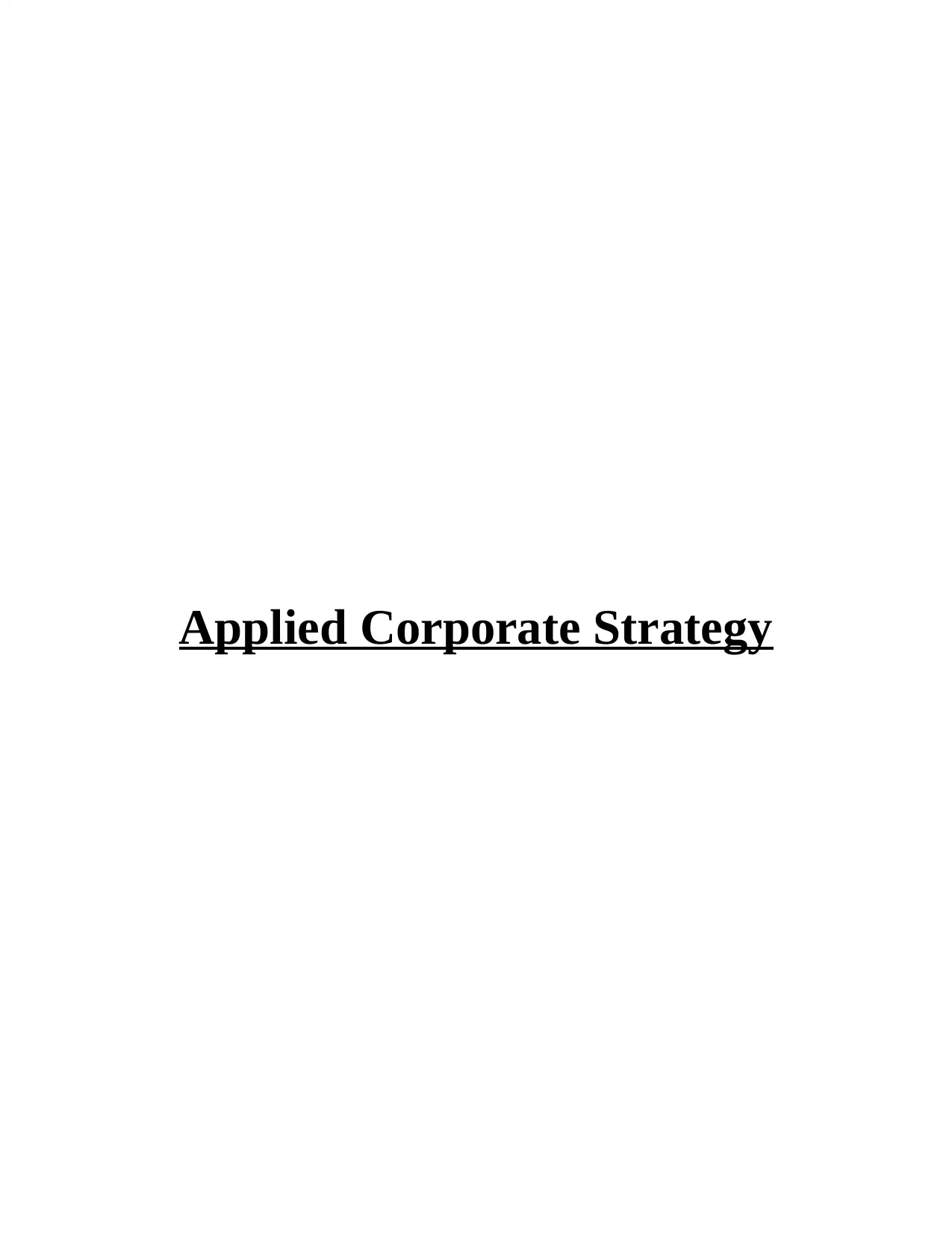
Applied Corporate Strategy
Paraphrase This Document
Need a fresh take? Get an instant paraphrase of this document with our AI Paraphraser

Table of Contents
INTRODUCTION...........................................................................................................................1
MAIN BODY...................................................................................................................................1
Question 1(External Analysis).........................................................................................................1
Introduction of the retail industry and strategy............................................................................1
Pestle Analysis.............................................................................................................................2
Porter's five forces.......................................................................................................................3
Question 2 (Internal Analysis).........................................................................................................4
Human Resource .........................................................................................................................4
Technical Resources....................................................................................................................5
Financial Resource ......................................................................................................................5
Intangible Resource ....................................................................................................................5
Physical Resource .......................................................................................................................6
Question 3 (Evaluation)...................................................................................................................6
Suitability.....................................................................................................................................6
Acceptability................................................................................................................................6
Feasibility.....................................................................................................................................6
REFERENCES................................................................................................................................7
INTRODUCTION...........................................................................................................................1
MAIN BODY...................................................................................................................................1
Question 1(External Analysis).........................................................................................................1
Introduction of the retail industry and strategy............................................................................1
Pestle Analysis.............................................................................................................................2
Porter's five forces.......................................................................................................................3
Question 2 (Internal Analysis).........................................................................................................4
Human Resource .........................................................................................................................4
Technical Resources....................................................................................................................5
Financial Resource ......................................................................................................................5
Intangible Resource ....................................................................................................................5
Physical Resource .......................................................................................................................6
Question 3 (Evaluation)...................................................................................................................6
Suitability.....................................................................................................................................6
Acceptability................................................................................................................................6
Feasibility.....................................................................................................................................6
REFERENCES................................................................................................................................7
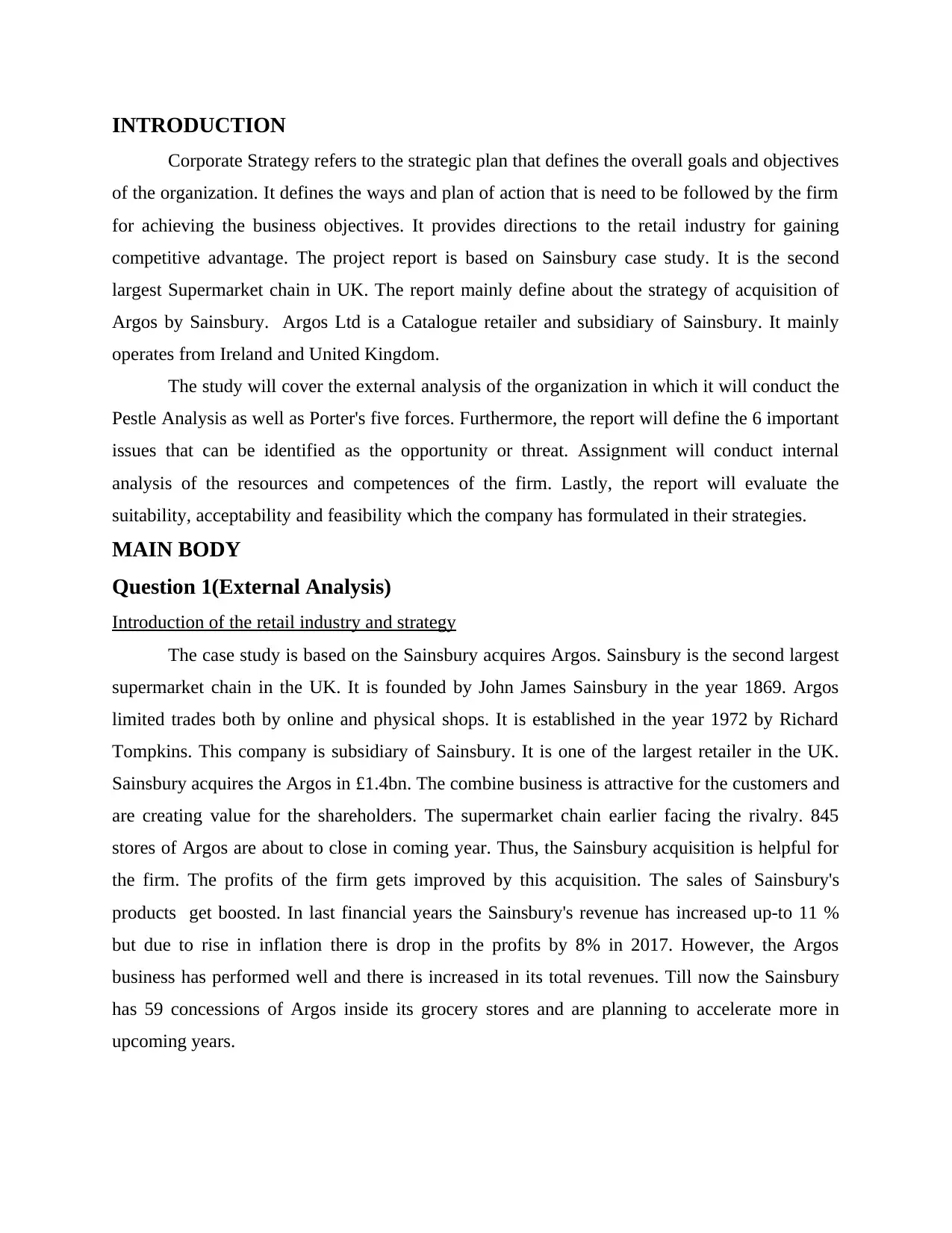
INTRODUCTION
Corporate Strategy refers to the strategic plan that defines the overall goals and objectives
of the organization. It defines the ways and plan of action that is need to be followed by the firm
for achieving the business objectives. It provides directions to the retail industry for gaining
competitive advantage. The project report is based on Sainsbury case study. It is the second
largest Supermarket chain in UK. The report mainly define about the strategy of acquisition of
Argos by Sainsbury. Argos Ltd is a Catalogue retailer and subsidiary of Sainsbury. It mainly
operates from Ireland and United Kingdom.
The study will cover the external analysis of the organization in which it will conduct the
Pestle Analysis as well as Porter's five forces. Furthermore, the report will define the 6 important
issues that can be identified as the opportunity or threat. Assignment will conduct internal
analysis of the resources and competences of the firm. Lastly, the report will evaluate the
suitability, acceptability and feasibility which the company has formulated in their strategies.
MAIN BODY
Question 1(External Analysis)
Introduction of the retail industry and strategy
The case study is based on the Sainsbury acquires Argos. Sainsbury is the second largest
supermarket chain in the UK. It is founded by John James Sainsbury in the year 1869. Argos
limited trades both by online and physical shops. It is established in the year 1972 by Richard
Tompkins. This company is subsidiary of Sainsbury. It is one of the largest retailer in the UK.
Sainsbury acquires the Argos in £1.4bn. The combine business is attractive for the customers and
are creating value for the shareholders. The supermarket chain earlier facing the rivalry. 845
stores of Argos are about to close in coming year. Thus, the Sainsbury acquisition is helpful for
the firm. The profits of the firm gets improved by this acquisition. The sales of Sainsbury's
products get boosted. In last financial years the Sainsbury's revenue has increased up-to 11 %
but due to rise in inflation there is drop in the profits by 8% in 2017. However, the Argos
business has performed well and there is increased in its total revenues. Till now the Sainsbury
has 59 concessions of Argos inside its grocery stores and are planning to accelerate more in
upcoming years.
Corporate Strategy refers to the strategic plan that defines the overall goals and objectives
of the organization. It defines the ways and plan of action that is need to be followed by the firm
for achieving the business objectives. It provides directions to the retail industry for gaining
competitive advantage. The project report is based on Sainsbury case study. It is the second
largest Supermarket chain in UK. The report mainly define about the strategy of acquisition of
Argos by Sainsbury. Argos Ltd is a Catalogue retailer and subsidiary of Sainsbury. It mainly
operates from Ireland and United Kingdom.
The study will cover the external analysis of the organization in which it will conduct the
Pestle Analysis as well as Porter's five forces. Furthermore, the report will define the 6 important
issues that can be identified as the opportunity or threat. Assignment will conduct internal
analysis of the resources and competences of the firm. Lastly, the report will evaluate the
suitability, acceptability and feasibility which the company has formulated in their strategies.
MAIN BODY
Question 1(External Analysis)
Introduction of the retail industry and strategy
The case study is based on the Sainsbury acquires Argos. Sainsbury is the second largest
supermarket chain in the UK. It is founded by John James Sainsbury in the year 1869. Argos
limited trades both by online and physical shops. It is established in the year 1972 by Richard
Tompkins. This company is subsidiary of Sainsbury. It is one of the largest retailer in the UK.
Sainsbury acquires the Argos in £1.4bn. The combine business is attractive for the customers and
are creating value for the shareholders. The supermarket chain earlier facing the rivalry. 845
stores of Argos are about to close in coming year. Thus, the Sainsbury acquisition is helpful for
the firm. The profits of the firm gets improved by this acquisition. The sales of Sainsbury's
products get boosted. In last financial years the Sainsbury's revenue has increased up-to 11 %
but due to rise in inflation there is drop in the profits by 8% in 2017. However, the Argos
business has performed well and there is increased in its total revenues. Till now the Sainsbury
has 59 concessions of Argos inside its grocery stores and are planning to accelerate more in
upcoming years.
⊘ This is a preview!⊘
Do you want full access?
Subscribe today to unlock all pages.

Trusted by 1+ million students worldwide
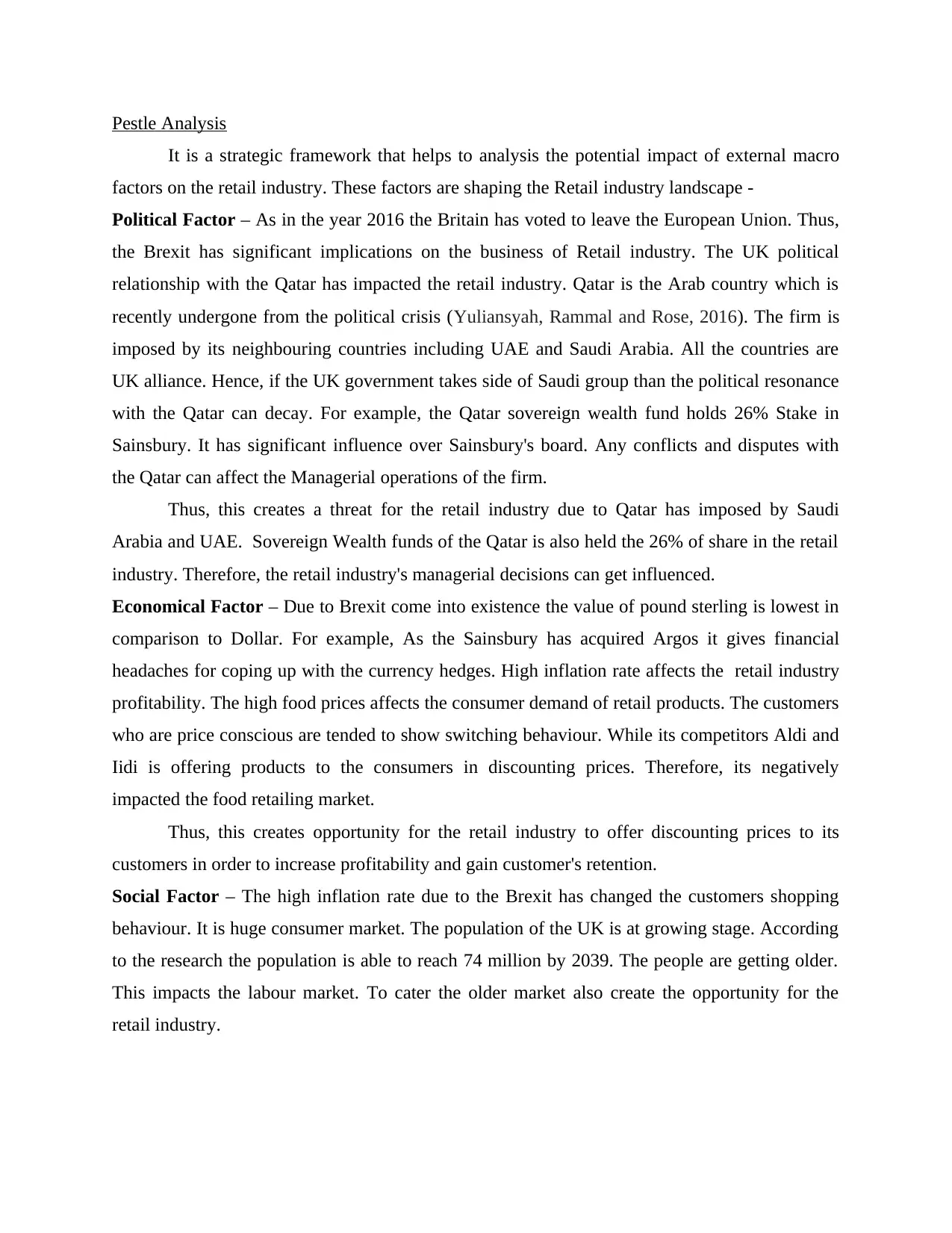
Pestle Analysis
It is a strategic framework that helps to analysis the potential impact of external macro
factors on the retail industry. These factors are shaping the Retail industry landscape -
Political Factor – As in the year 2016 the Britain has voted to leave the European Union. Thus,
the Brexit has significant implications on the business of Retail industry. The UK political
relationship with the Qatar has impacted the retail industry. Qatar is the Arab country which is
recently undergone from the political crisis (Yuliansyah, Rammal and Rose, 2016). The firm is
imposed by its neighbouring countries including UAE and Saudi Arabia. All the countries are
UK alliance. Hence, if the UK government takes side of Saudi group than the political resonance
with the Qatar can decay. For example, the Qatar sovereign wealth fund holds 26% Stake in
Sainsbury. It has significant influence over Sainsbury's board. Any conflicts and disputes with
the Qatar can affect the Managerial operations of the firm.
Thus, this creates a threat for the retail industry due to Qatar has imposed by Saudi
Arabia and UAE. Sovereign Wealth funds of the Qatar is also held the 26% of share in the retail
industry. Therefore, the retail industry's managerial decisions can get influenced.
Economical Factor – Due to Brexit come into existence the value of pound sterling is lowest in
comparison to Dollar. For example, As the Sainsbury has acquired Argos it gives financial
headaches for coping up with the currency hedges. High inflation rate affects the retail industry
profitability. The high food prices affects the consumer demand of retail products. The customers
who are price conscious are tended to show switching behaviour. While its competitors Aldi and
Iidi is offering products to the consumers in discounting prices. Therefore, its negatively
impacted the food retailing market.
Thus, this creates opportunity for the retail industry to offer discounting prices to its
customers in order to increase profitability and gain customer's retention.
Social Factor – The high inflation rate due to the Brexit has changed the customers shopping
behaviour. It is huge consumer market. The population of the UK is at growing stage. According
to the research the population is able to reach 74 million by 2039. The people are getting older.
This impacts the labour market. To cater the older market also create the opportunity for the
retail industry.
It is a strategic framework that helps to analysis the potential impact of external macro
factors on the retail industry. These factors are shaping the Retail industry landscape -
Political Factor – As in the year 2016 the Britain has voted to leave the European Union. Thus,
the Brexit has significant implications on the business of Retail industry. The UK political
relationship with the Qatar has impacted the retail industry. Qatar is the Arab country which is
recently undergone from the political crisis (Yuliansyah, Rammal and Rose, 2016). The firm is
imposed by its neighbouring countries including UAE and Saudi Arabia. All the countries are
UK alliance. Hence, if the UK government takes side of Saudi group than the political resonance
with the Qatar can decay. For example, the Qatar sovereign wealth fund holds 26% Stake in
Sainsbury. It has significant influence over Sainsbury's board. Any conflicts and disputes with
the Qatar can affect the Managerial operations of the firm.
Thus, this creates a threat for the retail industry due to Qatar has imposed by Saudi
Arabia and UAE. Sovereign Wealth funds of the Qatar is also held the 26% of share in the retail
industry. Therefore, the retail industry's managerial decisions can get influenced.
Economical Factor – Due to Brexit come into existence the value of pound sterling is lowest in
comparison to Dollar. For example, As the Sainsbury has acquired Argos it gives financial
headaches for coping up with the currency hedges. High inflation rate affects the retail industry
profitability. The high food prices affects the consumer demand of retail products. The customers
who are price conscious are tended to show switching behaviour. While its competitors Aldi and
Iidi is offering products to the consumers in discounting prices. Therefore, its negatively
impacted the food retailing market.
Thus, this creates opportunity for the retail industry to offer discounting prices to its
customers in order to increase profitability and gain customer's retention.
Social Factor – The high inflation rate due to the Brexit has changed the customers shopping
behaviour. It is huge consumer market. The population of the UK is at growing stage. According
to the research the population is able to reach 74 million by 2039. The people are getting older.
This impacts the labour market. To cater the older market also create the opportunity for the
retail industry.
Paraphrase This Document
Need a fresh take? Get an instant paraphrase of this document with our AI Paraphraser
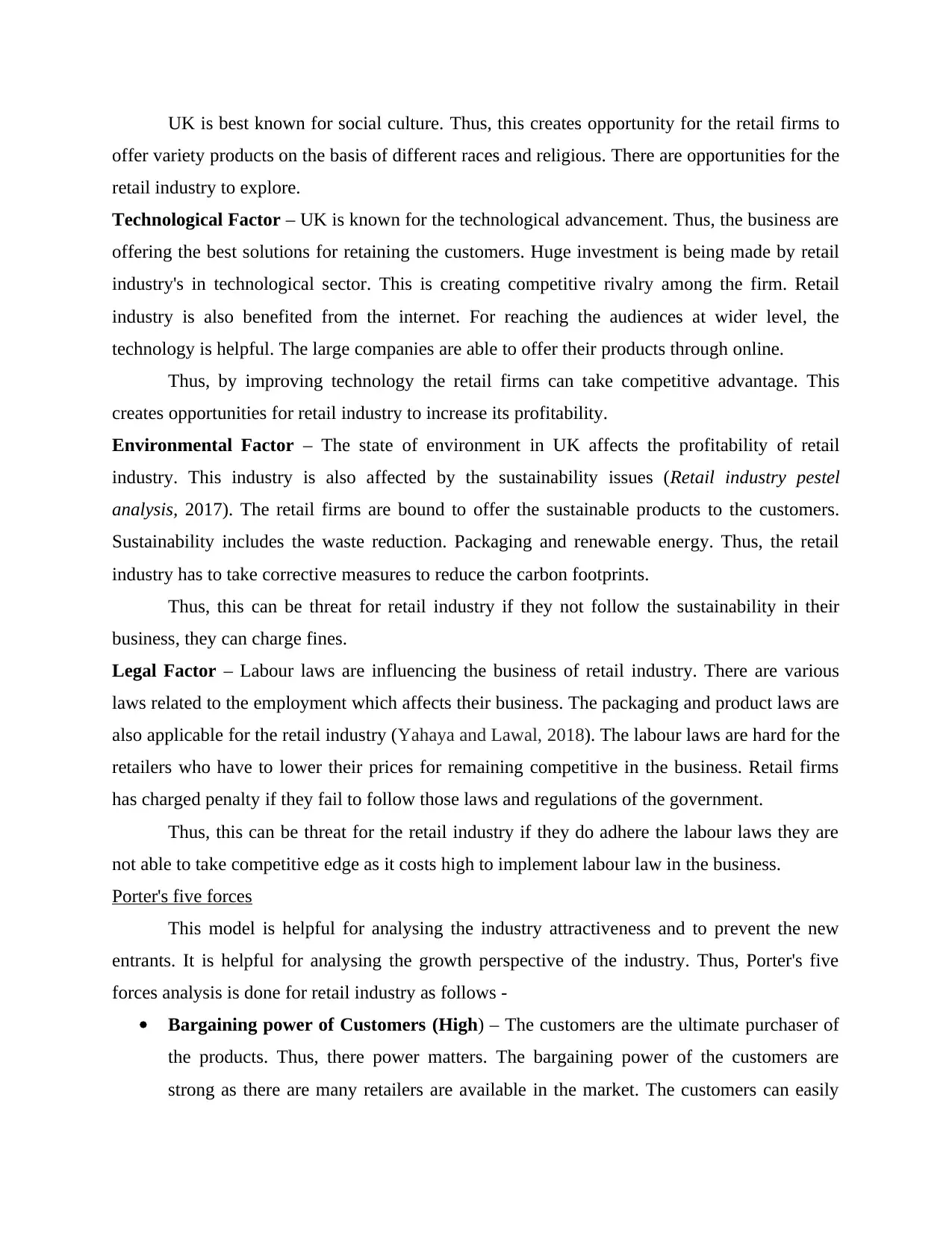
UK is best known for social culture. Thus, this creates opportunity for the retail firms to
offer variety products on the basis of different races and religious. There are opportunities for the
retail industry to explore.
Technological Factor – UK is known for the technological advancement. Thus, the business are
offering the best solutions for retaining the customers. Huge investment is being made by retail
industry's in technological sector. This is creating competitive rivalry among the firm. Retail
industry is also benefited from the internet. For reaching the audiences at wider level, the
technology is helpful. The large companies are able to offer their products through online.
Thus, by improving technology the retail firms can take competitive advantage. This
creates opportunities for retail industry to increase its profitability.
Environmental Factor – The state of environment in UK affects the profitability of retail
industry. This industry is also affected by the sustainability issues (Retail industry pestel
analysis, 2017). The retail firms are bound to offer the sustainable products to the customers.
Sustainability includes the waste reduction. Packaging and renewable energy. Thus, the retail
industry has to take corrective measures to reduce the carbon footprints.
Thus, this can be threat for retail industry if they not follow the sustainability in their
business, they can charge fines.
Legal Factor – Labour laws are influencing the business of retail industry. There are various
laws related to the employment which affects their business. The packaging and product laws are
also applicable for the retail industry (Yahaya and Lawal, 2018). The labour laws are hard for the
retailers who have to lower their prices for remaining competitive in the business. Retail firms
has charged penalty if they fail to follow those laws and regulations of the government.
Thus, this can be threat for the retail industry if they do adhere the labour laws they are
not able to take competitive edge as it costs high to implement labour law in the business.
Porter's five forces
This model is helpful for analysing the industry attractiveness and to prevent the new
entrants. It is helpful for analysing the growth perspective of the industry. Thus, Porter's five
forces analysis is done for retail industry as follows -
Bargaining power of Customers (High) – The customers are the ultimate purchaser of
the products. Thus, there power matters. The bargaining power of the customers are
strong as there are many retailers are available in the market. The customers can easily
offer variety products on the basis of different races and religious. There are opportunities for the
retail industry to explore.
Technological Factor – UK is known for the technological advancement. Thus, the business are
offering the best solutions for retaining the customers. Huge investment is being made by retail
industry's in technological sector. This is creating competitive rivalry among the firm. Retail
industry is also benefited from the internet. For reaching the audiences at wider level, the
technology is helpful. The large companies are able to offer their products through online.
Thus, by improving technology the retail firms can take competitive advantage. This
creates opportunities for retail industry to increase its profitability.
Environmental Factor – The state of environment in UK affects the profitability of retail
industry. This industry is also affected by the sustainability issues (Retail industry pestel
analysis, 2017). The retail firms are bound to offer the sustainable products to the customers.
Sustainability includes the waste reduction. Packaging and renewable energy. Thus, the retail
industry has to take corrective measures to reduce the carbon footprints.
Thus, this can be threat for retail industry if they not follow the sustainability in their
business, they can charge fines.
Legal Factor – Labour laws are influencing the business of retail industry. There are various
laws related to the employment which affects their business. The packaging and product laws are
also applicable for the retail industry (Yahaya and Lawal, 2018). The labour laws are hard for the
retailers who have to lower their prices for remaining competitive in the business. Retail firms
has charged penalty if they fail to follow those laws and regulations of the government.
Thus, this can be threat for the retail industry if they do adhere the labour laws they are
not able to take competitive edge as it costs high to implement labour law in the business.
Porter's five forces
This model is helpful for analysing the industry attractiveness and to prevent the new
entrants. It is helpful for analysing the growth perspective of the industry. Thus, Porter's five
forces analysis is done for retail industry as follows -
Bargaining power of Customers (High) – The customers are the ultimate purchaser of
the products. Thus, there power matters. The bargaining power of the customers are
strong as there are many retailers are available in the market. The customers can easily
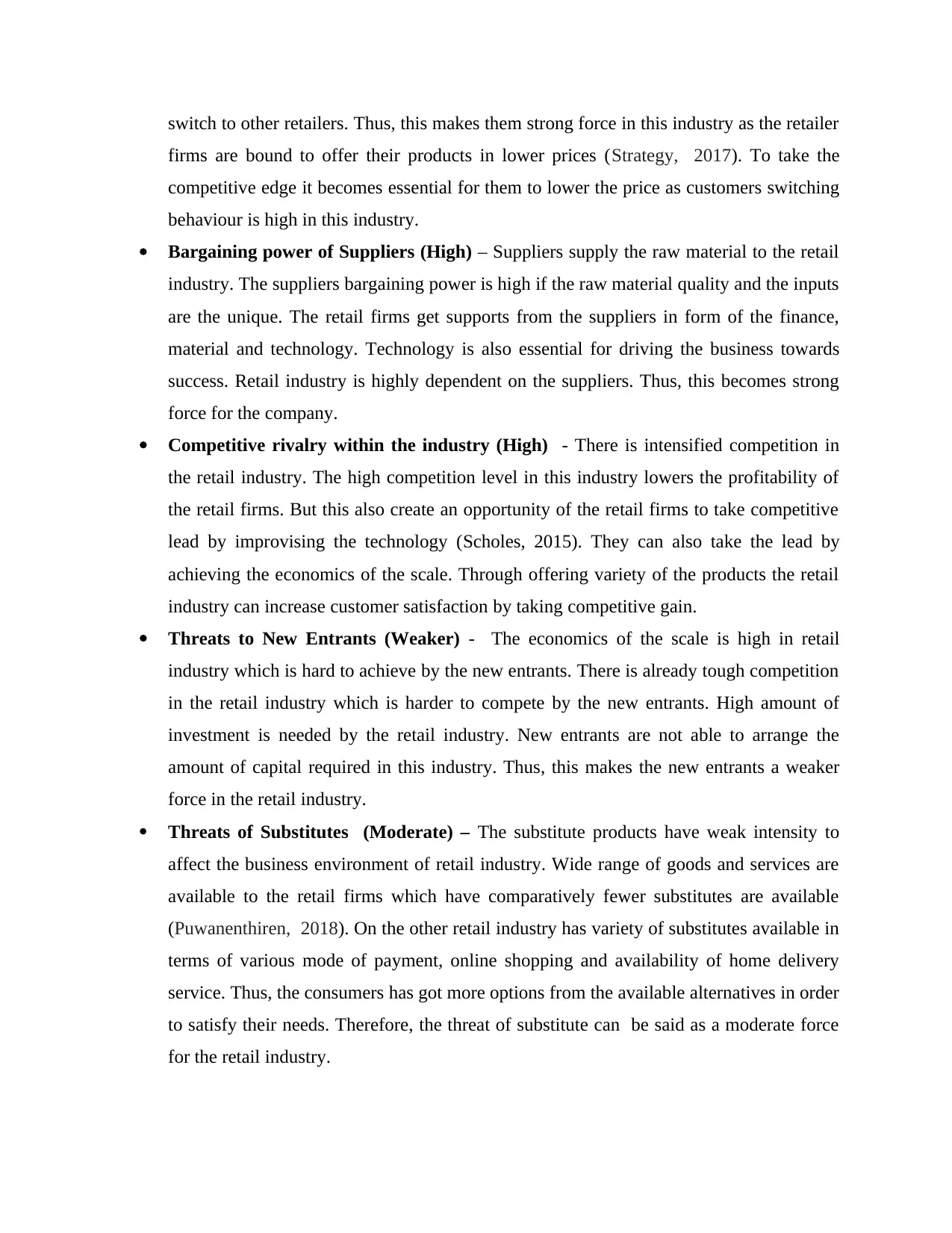
switch to other retailers. Thus, this makes them strong force in this industry as the retailer
firms are bound to offer their products in lower prices (Strategy, 2017). To take the
competitive edge it becomes essential for them to lower the price as customers switching
behaviour is high in this industry.
Bargaining power of Suppliers (High) – Suppliers supply the raw material to the retail
industry. The suppliers bargaining power is high if the raw material quality and the inputs
are the unique. The retail firms get supports from the suppliers in form of the finance,
material and technology. Technology is also essential for driving the business towards
success. Retail industry is highly dependent on the suppliers. Thus, this becomes strong
force for the company.
Competitive rivalry within the industry (High) - There is intensified competition in
the retail industry. The high competition level in this industry lowers the profitability of
the retail firms. But this also create an opportunity of the retail firms to take competitive
lead by improvising the technology (Scholes, 2015). They can also take the lead by
achieving the economics of the scale. Through offering variety of the products the retail
industry can increase customer satisfaction by taking competitive gain.
Threats to New Entrants (Weaker) - The economics of the scale is high in retail
industry which is hard to achieve by the new entrants. There is already tough competition
in the retail industry which is harder to compete by the new entrants. High amount of
investment is needed by the retail industry. New entrants are not able to arrange the
amount of capital required in this industry. Thus, this makes the new entrants a weaker
force in the retail industry.
Threats of Substitutes (Moderate) – The substitute products have weak intensity to
affect the business environment of retail industry. Wide range of goods and services are
available to the retail firms which have comparatively fewer substitutes are available
(Puwanenthiren, 2018). On the other retail industry has variety of substitutes available in
terms of various mode of payment, online shopping and availability of home delivery
service. Thus, the consumers has got more options from the available alternatives in order
to satisfy their needs. Therefore, the threat of substitute can be said as a moderate force
for the retail industry.
firms are bound to offer their products in lower prices (Strategy, 2017). To take the
competitive edge it becomes essential for them to lower the price as customers switching
behaviour is high in this industry.
Bargaining power of Suppliers (High) – Suppliers supply the raw material to the retail
industry. The suppliers bargaining power is high if the raw material quality and the inputs
are the unique. The retail firms get supports from the suppliers in form of the finance,
material and technology. Technology is also essential for driving the business towards
success. Retail industry is highly dependent on the suppliers. Thus, this becomes strong
force for the company.
Competitive rivalry within the industry (High) - There is intensified competition in
the retail industry. The high competition level in this industry lowers the profitability of
the retail firms. But this also create an opportunity of the retail firms to take competitive
lead by improvising the technology (Scholes, 2015). They can also take the lead by
achieving the economics of the scale. Through offering variety of the products the retail
industry can increase customer satisfaction by taking competitive gain.
Threats to New Entrants (Weaker) - The economics of the scale is high in retail
industry which is hard to achieve by the new entrants. There is already tough competition
in the retail industry which is harder to compete by the new entrants. High amount of
investment is needed by the retail industry. New entrants are not able to arrange the
amount of capital required in this industry. Thus, this makes the new entrants a weaker
force in the retail industry.
Threats of Substitutes (Moderate) – The substitute products have weak intensity to
affect the business environment of retail industry. Wide range of goods and services are
available to the retail firms which have comparatively fewer substitutes are available
(Puwanenthiren, 2018). On the other retail industry has variety of substitutes available in
terms of various mode of payment, online shopping and availability of home delivery
service. Thus, the consumers has got more options from the available alternatives in order
to satisfy their needs. Therefore, the threat of substitute can be said as a moderate force
for the retail industry.
⊘ This is a preview!⊘
Do you want full access?
Subscribe today to unlock all pages.

Trusted by 1+ million students worldwide
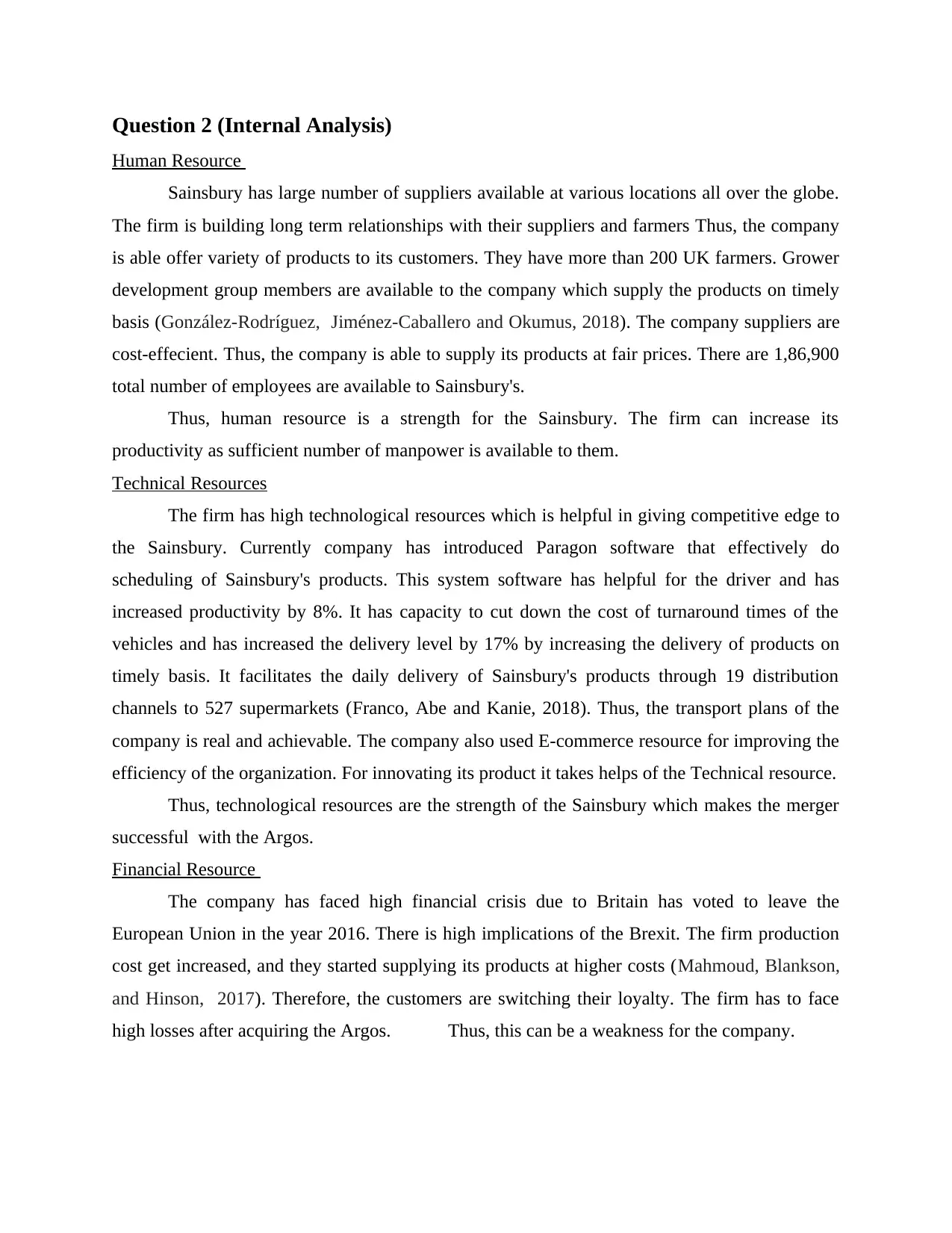
Question 2 (Internal Analysis)
Human Resource
Sainsbury has large number of suppliers available at various locations all over the globe.
The firm is building long term relationships with their suppliers and farmers Thus, the company
is able offer variety of products to its customers. They have more than 200 UK farmers. Grower
development group members are available to the company which supply the products on timely
basis (González-Rodríguez, Jiménez-Caballero and Okumus, 2018). The company suppliers are
cost-effecient. Thus, the company is able to supply its products at fair prices. There are 1,86,900
total number of employees are available to Sainsbury's.
Thus, human resource is a strength for the Sainsbury. The firm can increase its
productivity as sufficient number of manpower is available to them.
Technical Resources
The firm has high technological resources which is helpful in giving competitive edge to
the Sainsbury. Currently company has introduced Paragon software that effectively do
scheduling of Sainsbury's products. This system software has helpful for the driver and has
increased productivity by 8%. It has capacity to cut down the cost of turnaround times of the
vehicles and has increased the delivery level by 17% by increasing the delivery of products on
timely basis. It facilitates the daily delivery of Sainsbury's products through 19 distribution
channels to 527 supermarkets (Franco, Abe and Kanie, 2018). Thus, the transport plans of the
company is real and achievable. The company also used E-commerce resource for improving the
efficiency of the organization. For innovating its product it takes helps of the Technical resource.
Thus, technological resources are the strength of the Sainsbury which makes the merger
successful with the Argos.
Financial Resource
The company has faced high financial crisis due to Britain has voted to leave the
European Union in the year 2016. There is high implications of the Brexit. The firm production
cost get increased, and they started supplying its products at higher costs (Mahmoud, Blankson,
and Hinson, 2017). Therefore, the customers are switching their loyalty. The firm has to face
high losses after acquiring the Argos. Thus, this can be a weakness for the company.
Human Resource
Sainsbury has large number of suppliers available at various locations all over the globe.
The firm is building long term relationships with their suppliers and farmers Thus, the company
is able offer variety of products to its customers. They have more than 200 UK farmers. Grower
development group members are available to the company which supply the products on timely
basis (González-Rodríguez, Jiménez-Caballero and Okumus, 2018). The company suppliers are
cost-effecient. Thus, the company is able to supply its products at fair prices. There are 1,86,900
total number of employees are available to Sainsbury's.
Thus, human resource is a strength for the Sainsbury. The firm can increase its
productivity as sufficient number of manpower is available to them.
Technical Resources
The firm has high technological resources which is helpful in giving competitive edge to
the Sainsbury. Currently company has introduced Paragon software that effectively do
scheduling of Sainsbury's products. This system software has helpful for the driver and has
increased productivity by 8%. It has capacity to cut down the cost of turnaround times of the
vehicles and has increased the delivery level by 17% by increasing the delivery of products on
timely basis. It facilitates the daily delivery of Sainsbury's products through 19 distribution
channels to 527 supermarkets (Franco, Abe and Kanie, 2018). Thus, the transport plans of the
company is real and achievable. The company also used E-commerce resource for improving the
efficiency of the organization. For innovating its product it takes helps of the Technical resource.
Thus, technological resources are the strength of the Sainsbury which makes the merger
successful with the Argos.
Financial Resource
The company has faced high financial crisis due to Britain has voted to leave the
European Union in the year 2016. There is high implications of the Brexit. The firm production
cost get increased, and they started supplying its products at higher costs (Mahmoud, Blankson,
and Hinson, 2017). Therefore, the customers are switching their loyalty. The firm has to face
high losses after acquiring the Argos. Thus, this can be a weakness for the company.
Paraphrase This Document
Need a fresh take? Get an instant paraphrase of this document with our AI Paraphraser
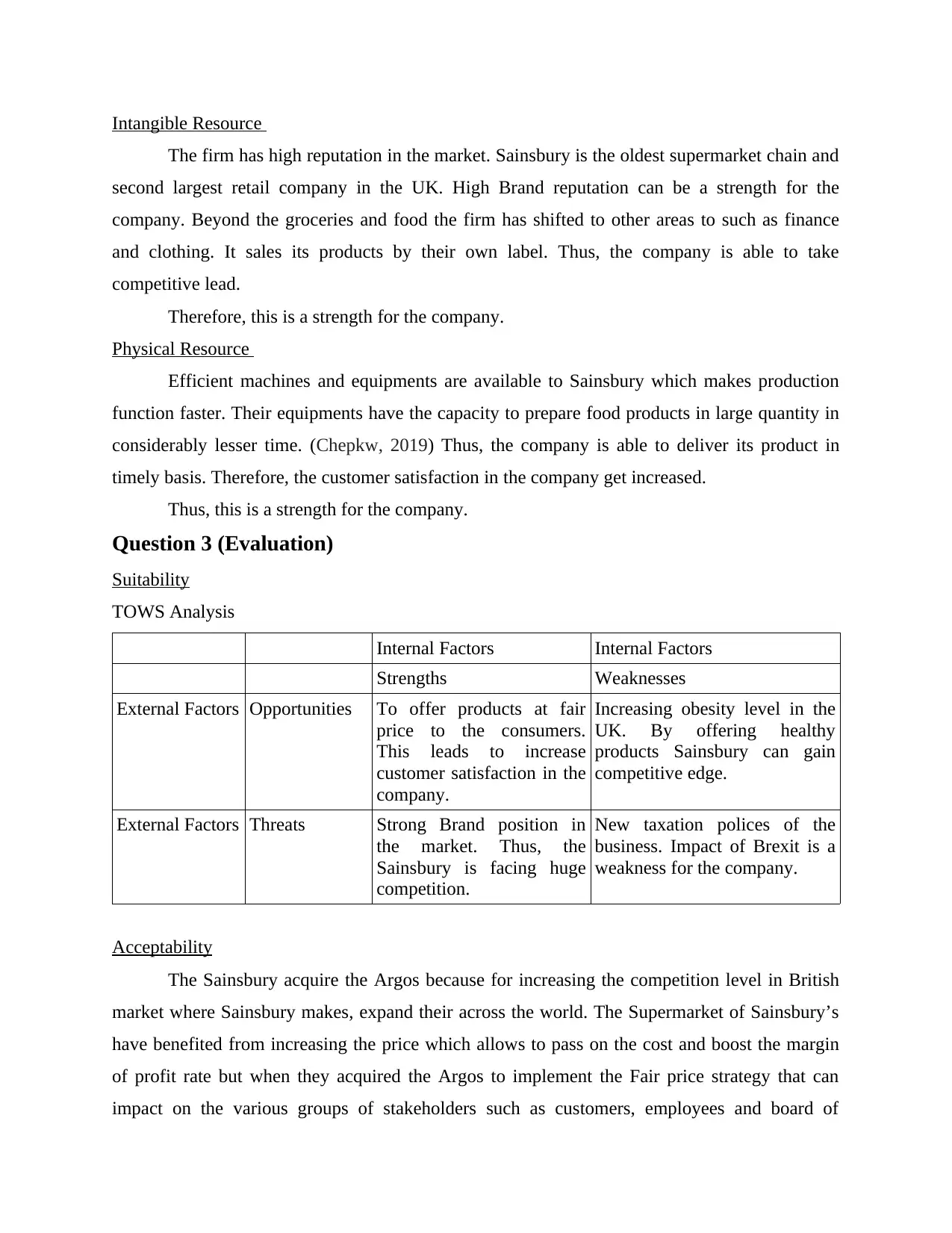
Intangible Resource
The firm has high reputation in the market. Sainsbury is the oldest supermarket chain and
second largest retail company in the UK. High Brand reputation can be a strength for the
company. Beyond the groceries and food the firm has shifted to other areas to such as finance
and clothing. It sales its products by their own label. Thus, the company is able to take
competitive lead.
Therefore, this is a strength for the company.
Physical Resource
Efficient machines and equipments are available to Sainsbury which makes production
function faster. Their equipments have the capacity to prepare food products in large quantity in
considerably lesser time. (Chepkw, 2019) Thus, the company is able to deliver its product in
timely basis. Therefore, the customer satisfaction in the company get increased.
Thus, this is a strength for the company.
Question 3 (Evaluation)
Suitability
TOWS Analysis
Internal Factors Internal Factors
Strengths Weaknesses
External Factors Opportunities To offer products at fair
price to the consumers.
This leads to increase
customer satisfaction in the
company.
Increasing obesity level in the
UK. By offering healthy
products Sainsbury can gain
competitive edge.
External Factors Threats Strong Brand position in
the market. Thus, the
Sainsbury is facing huge
competition.
New taxation polices of the
business. Impact of Brexit is a
weakness for the company.
Acceptability
The Sainsbury acquire the Argos because for increasing the competition level in British
market where Sainsbury makes, expand their across the world. The Supermarket of Sainsbury’s
have benefited from increasing the price which allows to pass on the cost and boost the margin
of profit rate but when they acquired the Argos to implement the Fair price strategy that can
impact on the various groups of stakeholders such as customers, employees and board of
The firm has high reputation in the market. Sainsbury is the oldest supermarket chain and
second largest retail company in the UK. High Brand reputation can be a strength for the
company. Beyond the groceries and food the firm has shifted to other areas to such as finance
and clothing. It sales its products by their own label. Thus, the company is able to take
competitive lead.
Therefore, this is a strength for the company.
Physical Resource
Efficient machines and equipments are available to Sainsbury which makes production
function faster. Their equipments have the capacity to prepare food products in large quantity in
considerably lesser time. (Chepkw, 2019) Thus, the company is able to deliver its product in
timely basis. Therefore, the customer satisfaction in the company get increased.
Thus, this is a strength for the company.
Question 3 (Evaluation)
Suitability
TOWS Analysis
Internal Factors Internal Factors
Strengths Weaknesses
External Factors Opportunities To offer products at fair
price to the consumers.
This leads to increase
customer satisfaction in the
company.
Increasing obesity level in the
UK. By offering healthy
products Sainsbury can gain
competitive edge.
External Factors Threats Strong Brand position in
the market. Thus, the
Sainsbury is facing huge
competition.
New taxation polices of the
business. Impact of Brexit is a
weakness for the company.
Acceptability
The Sainsbury acquire the Argos because for increasing the competition level in British
market where Sainsbury makes, expand their across the world. The Supermarket of Sainsbury’s
have benefited from increasing the price which allows to pass on the cost and boost the margin
of profit rate but when they acquired the Argos to implement the Fair price strategy that can
impact on the various groups of stakeholders such as customers, employees and board of

directors etc. In global marketplace, the potential consumers want use more choice which faster
than other. It has increased the digital technology and usage of mobile phones (Abdi, 2018).
Sainsbury has planning the fair price strategy that help for supplying the better quality of product
and services at price low price (Ike, 2017). In this way, it will be target the customers those who
will able to shop the item from stores, online and mobile devices. On the other hand, it also
reasons for Sainsbury’s wants to acquire the Argos because there are large number of stores sell
the product by online platform. It useful for Sainsbury to increase the productivity and
profitability in global marketplace. There are three groups of stakeholders such as customers,
employees and board of directors, managers etc.
According to interest matrix, it can determine that stakeholder to manage the closely and also
putting minimum efforts. It helps for managing the time of channel which is the most power and
interest towards the success of business.
Figure 1Matrix of Interest
(Source: Interest Matrix. 2018)
Managers are the consulting with the strategy and sign off the authority to implement the
strategy in the business development. They are affecting on the manager due to minimize the
sales of product and services in global marketplace. Manager is closely managing and ensure the
business profit and revenue. On the other hand, the other stakeholder such as Board of directors
that shows their high level of interest towards the fair price strategy. It may be impacts on the
bottom line of Sainsbury. Directors may show high interest towards the bottom line of
enterprises. This strategy will keep satisfied the customer because they want to buy the high
quality of product in less price. This will help for satisfied the customer and also useful for
than other. It has increased the digital technology and usage of mobile phones (Abdi, 2018).
Sainsbury has planning the fair price strategy that help for supplying the better quality of product
and services at price low price (Ike, 2017). In this way, it will be target the customers those who
will able to shop the item from stores, online and mobile devices. On the other hand, it also
reasons for Sainsbury’s wants to acquire the Argos because there are large number of stores sell
the product by online platform. It useful for Sainsbury to increase the productivity and
profitability in global marketplace. There are three groups of stakeholders such as customers,
employees and board of directors, managers etc.
According to interest matrix, it can determine that stakeholder to manage the closely and also
putting minimum efforts. It helps for managing the time of channel which is the most power and
interest towards the success of business.
Figure 1Matrix of Interest
(Source: Interest Matrix. 2018)
Managers are the consulting with the strategy and sign off the authority to implement the
strategy in the business development. They are affecting on the manager due to minimize the
sales of product and services in global marketplace. Manager is closely managing and ensure the
business profit and revenue. On the other hand, the other stakeholder such as Board of directors
that shows their high level of interest towards the fair price strategy. It may be impacts on the
bottom line of Sainsbury. Directors may show high interest towards the bottom line of
enterprises. This strategy will keep satisfied the customer because they want to buy the high
quality of product in less price. This will help for satisfied the customer and also useful for
⊘ This is a preview!⊘
Do you want full access?
Subscribe today to unlock all pages.

Trusted by 1+ million students worldwide
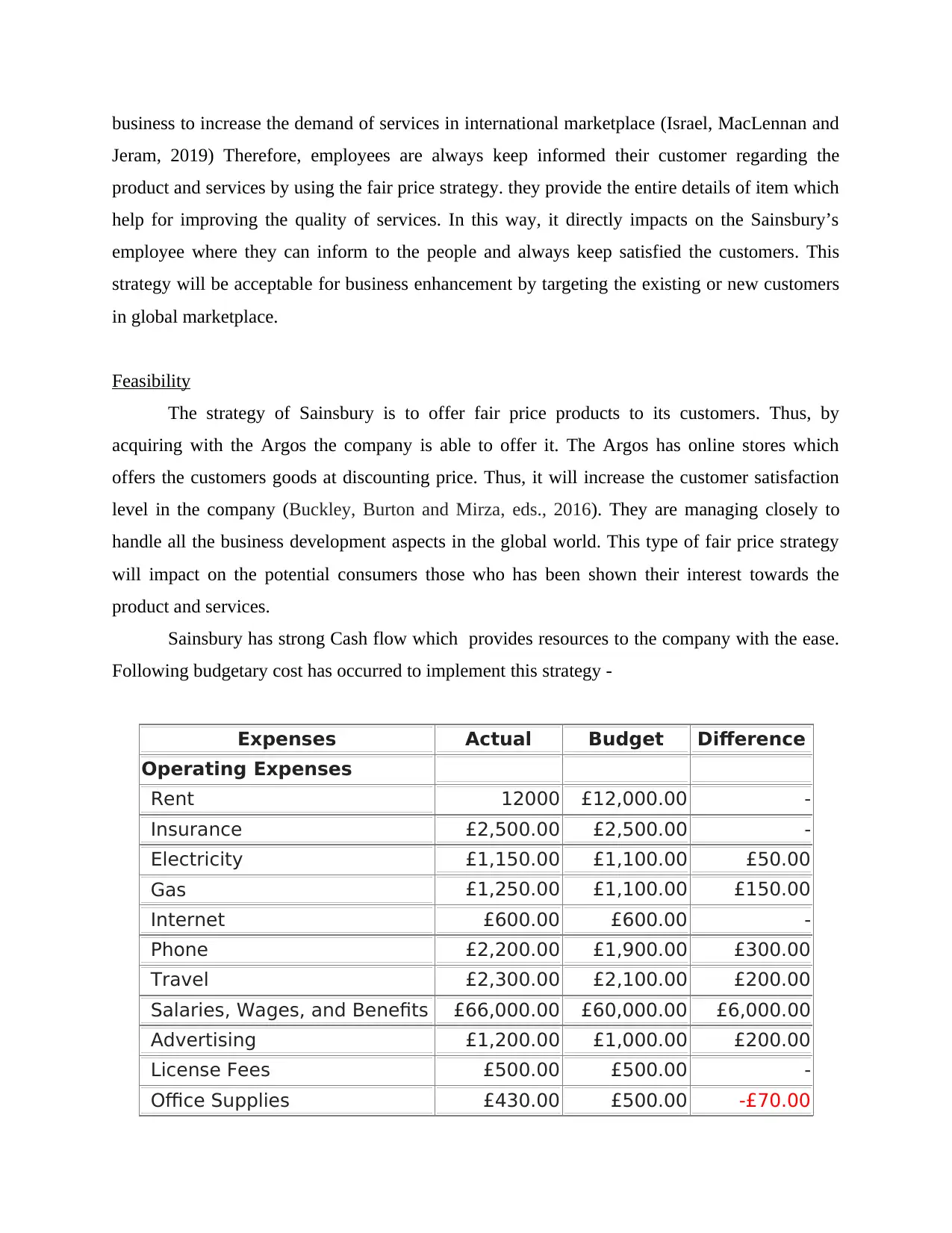
business to increase the demand of services in international marketplace (Israel, MacLennan and
Jeram, 2019) Therefore, employees are always keep informed their customer regarding the
product and services by using the fair price strategy. they provide the entire details of item which
help for improving the quality of services. In this way, it directly impacts on the Sainsbury’s
employee where they can inform to the people and always keep satisfied the customers. This
strategy will be acceptable for business enhancement by targeting the existing or new customers
in global marketplace.
Feasibility
The strategy of Sainsbury is to offer fair price products to its customers. Thus, by
acquiring with the Argos the company is able to offer it. The Argos has online stores which
offers the customers goods at discounting price. Thus, it will increase the customer satisfaction
level in the company (Buckley, Burton and Mirza, eds., 2016). They are managing closely to
handle all the business development aspects in the global world. This type of fair price strategy
will impact on the potential consumers those who has been shown their interest towards the
product and services.
Sainsbury has strong Cash flow which provides resources to the company with the ease.
Following budgetary cost has occurred to implement this strategy -
Expenses Actual Budget Difference
Operating Expenses
Rent 12000 £12,000.00 -
Insurance £2,500.00 £2,500.00 -
Electricity £1,150.00 £1,100.00 £50.00
Gas £1,250.00 £1,100.00 £150.00
Internet £600.00 £600.00 -
Phone £2,200.00 £1,900.00 £300.00
Travel £2,300.00 £2,100.00 £200.00
Salaries, Wages, and Benefits £66,000.00 £60,000.00 £6,000.00
Advertising £1,200.00 £1,000.00 £200.00
License Fees £500.00 £500.00 -
Office Supplies £430.00 £500.00 -£70.00
Jeram, 2019) Therefore, employees are always keep informed their customer regarding the
product and services by using the fair price strategy. they provide the entire details of item which
help for improving the quality of services. In this way, it directly impacts on the Sainsbury’s
employee where they can inform to the people and always keep satisfied the customers. This
strategy will be acceptable for business enhancement by targeting the existing or new customers
in global marketplace.
Feasibility
The strategy of Sainsbury is to offer fair price products to its customers. Thus, by
acquiring with the Argos the company is able to offer it. The Argos has online stores which
offers the customers goods at discounting price. Thus, it will increase the customer satisfaction
level in the company (Buckley, Burton and Mirza, eds., 2016). They are managing closely to
handle all the business development aspects in the global world. This type of fair price strategy
will impact on the potential consumers those who has been shown their interest towards the
product and services.
Sainsbury has strong Cash flow which provides resources to the company with the ease.
Following budgetary cost has occurred to implement this strategy -
Expenses Actual Budget Difference
Operating Expenses
Rent 12000 £12,000.00 -
Insurance £2,500.00 £2,500.00 -
Electricity £1,150.00 £1,100.00 £50.00
Gas £1,250.00 £1,100.00 £150.00
Internet £600.00 £600.00 -
Phone £2,200.00 £1,900.00 £300.00
Travel £2,300.00 £2,100.00 £200.00
Salaries, Wages, and Benefits £66,000.00 £60,000.00 £6,000.00
Advertising £1,200.00 £1,000.00 £200.00
License Fees £500.00 £500.00 -
Office Supplies £430.00 £500.00 -£70.00
Paraphrase This Document
Need a fresh take? Get an instant paraphrase of this document with our AI Paraphraser
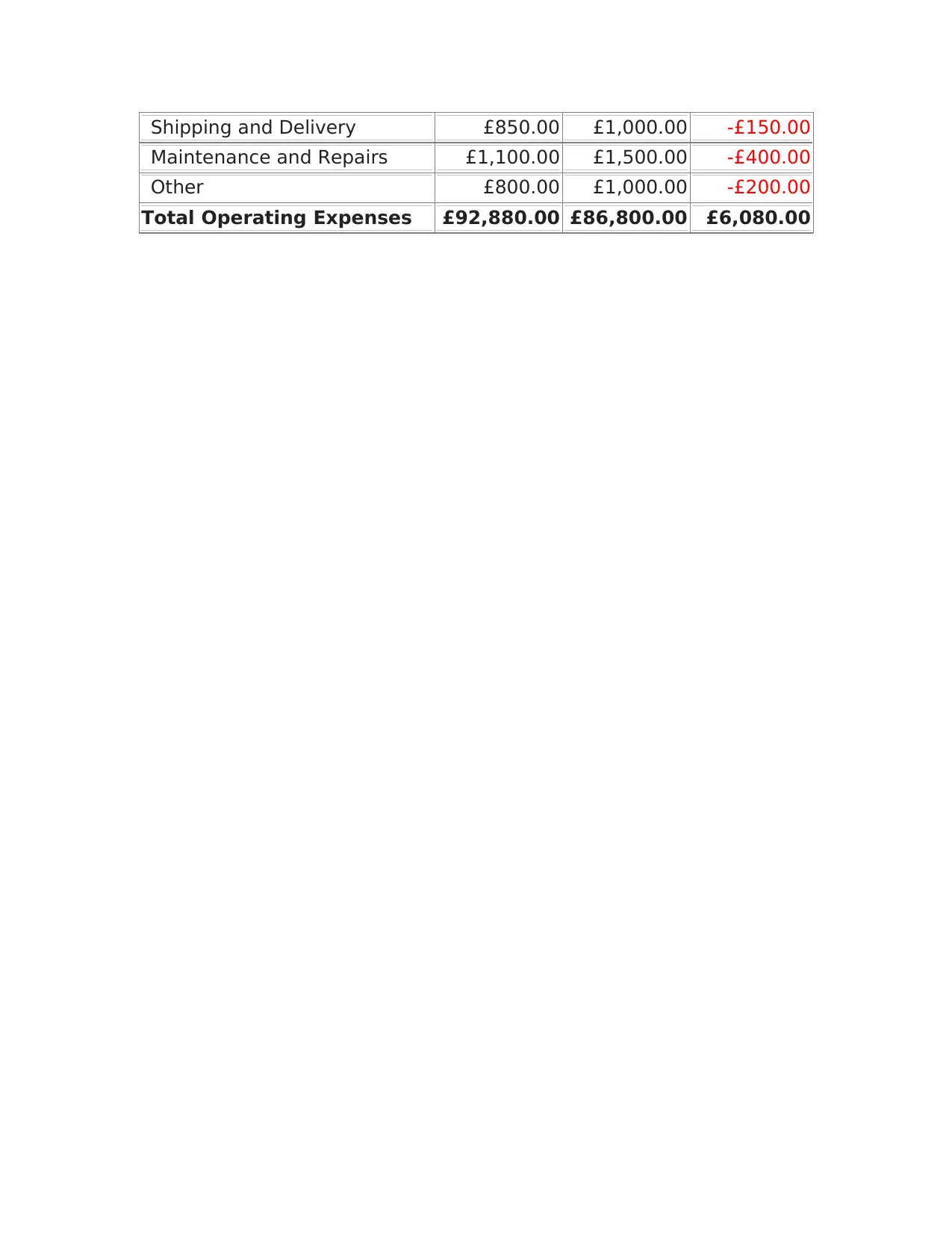
Shipping and Delivery £850.00 £1,000.00 -£150.00
Maintenance and Repairs £1,100.00 £1,500.00 -£400.00
Other £800.00 £1,000.00 -£200.00
Total Operating Expenses £92,880.00 £86,800.00 £6,080.00
Maintenance and Repairs £1,100.00 £1,500.00 -£400.00
Other £800.00 £1,000.00 -£200.00
Total Operating Expenses £92,880.00 £86,800.00 £6,080.00
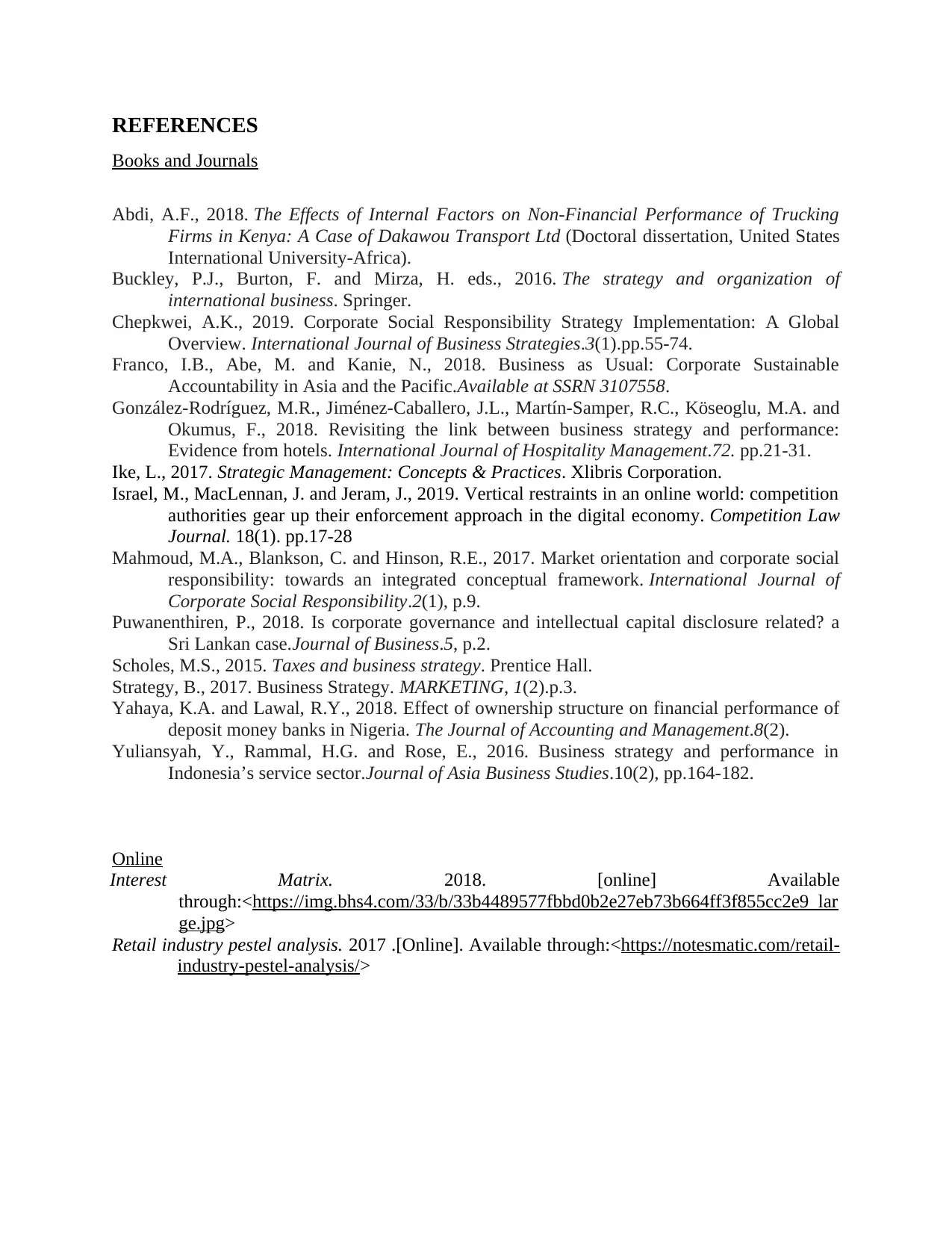
REFERENCES
Books and Journals
Abdi, A.F., 2018. The Effects of Internal Factors on Non-Financial Performance of Trucking
Firms in Kenya: A Case of Dakawou Transport Ltd (Doctoral dissertation, United States
International University-Africa).
Buckley, P.J., Burton, F. and Mirza, H. eds., 2016. The strategy and organization of
international business. Springer.
Chepkwei, A.K., 2019. Corporate Social Responsibility Strategy Implementation: A Global
Overview. International Journal of Business Strategies.3(1).pp.55-74.
Franco, I.B., Abe, M. and Kanie, N., 2018. Business as Usual: Corporate Sustainable
Accountability in Asia and the Pacific.Available at SSRN 3107558.
González-Rodríguez, M.R., Jiménez-Caballero, J.L., Martín-Samper, R.C., Köseoglu, M.A. and
Okumus, F., 2018. Revisiting the link between business strategy and performance:
Evidence from hotels. International Journal of Hospitality Management.72. pp.21-31.
Ike, L., 2017. Strategic Management: Concepts & Practices. Xlibris Corporation.
Israel, M., MacLennan, J. and Jeram, J., 2019. Vertical restraints in an online world: competition
authorities gear up their enforcement approach in the digital economy. Competition Law
Journal. 18(1). pp.17-28
Mahmoud, M.A., Blankson, C. and Hinson, R.E., 2017. Market orientation and corporate social
responsibility: towards an integrated conceptual framework. International Journal of
Corporate Social Responsibility.2(1), p.9.
Puwanenthiren, P., 2018. Is corporate governance and intellectual capital disclosure related? a
Sri Lankan case.Journal of Business.5, p.2.
Scholes, M.S., 2015. Taxes and business strategy. Prentice Hall.
Strategy, B., 2017. Business Strategy. MARKETING, 1(2).p.3.
Yahaya, K.A. and Lawal, R.Y., 2018. Effect of ownership structure on financial performance of
deposit money banks in Nigeria. The Journal of Accounting and Management.8(2).
Yuliansyah, Y., Rammal, H.G. and Rose, E., 2016. Business strategy and performance in
Indonesia’s service sector.Journal of Asia Business Studies.10(2), pp.164-182.
Online
Interest Matrix. 2018. [online] Available
through:<https://img.bhs4.com/33/b/33b4489577fbbd0b2e27eb73b664ff3f855cc2e9_lar
ge.jpg>
Retail industry pestel analysis. 2017 .[Online]. Available through:<https://notesmatic.com/retail-
industry-pestel-analysis/>
Books and Journals
Abdi, A.F., 2018. The Effects of Internal Factors on Non-Financial Performance of Trucking
Firms in Kenya: A Case of Dakawou Transport Ltd (Doctoral dissertation, United States
International University-Africa).
Buckley, P.J., Burton, F. and Mirza, H. eds., 2016. The strategy and organization of
international business. Springer.
Chepkwei, A.K., 2019. Corporate Social Responsibility Strategy Implementation: A Global
Overview. International Journal of Business Strategies.3(1).pp.55-74.
Franco, I.B., Abe, M. and Kanie, N., 2018. Business as Usual: Corporate Sustainable
Accountability in Asia and the Pacific.Available at SSRN 3107558.
González-Rodríguez, M.R., Jiménez-Caballero, J.L., Martín-Samper, R.C., Köseoglu, M.A. and
Okumus, F., 2018. Revisiting the link between business strategy and performance:
Evidence from hotels. International Journal of Hospitality Management.72. pp.21-31.
Ike, L., 2017. Strategic Management: Concepts & Practices. Xlibris Corporation.
Israel, M., MacLennan, J. and Jeram, J., 2019. Vertical restraints in an online world: competition
authorities gear up their enforcement approach in the digital economy. Competition Law
Journal. 18(1). pp.17-28
Mahmoud, M.A., Blankson, C. and Hinson, R.E., 2017. Market orientation and corporate social
responsibility: towards an integrated conceptual framework. International Journal of
Corporate Social Responsibility.2(1), p.9.
Puwanenthiren, P., 2018. Is corporate governance and intellectual capital disclosure related? a
Sri Lankan case.Journal of Business.5, p.2.
Scholes, M.S., 2015. Taxes and business strategy. Prentice Hall.
Strategy, B., 2017. Business Strategy. MARKETING, 1(2).p.3.
Yahaya, K.A. and Lawal, R.Y., 2018. Effect of ownership structure on financial performance of
deposit money banks in Nigeria. The Journal of Accounting and Management.8(2).
Yuliansyah, Y., Rammal, H.G. and Rose, E., 2016. Business strategy and performance in
Indonesia’s service sector.Journal of Asia Business Studies.10(2), pp.164-182.
Online
Interest Matrix. 2018. [online] Available
through:<https://img.bhs4.com/33/b/33b4489577fbbd0b2e27eb73b664ff3f855cc2e9_lar
ge.jpg>
Retail industry pestel analysis. 2017 .[Online]. Available through:<https://notesmatic.com/retail-
industry-pestel-analysis/>
⊘ This is a preview!⊘
Do you want full access?
Subscribe today to unlock all pages.

Trusted by 1+ million students worldwide
1 out of 12
Related Documents
Your All-in-One AI-Powered Toolkit for Academic Success.
+13062052269
info@desklib.com
Available 24*7 on WhatsApp / Email
![[object Object]](/_next/static/media/star-bottom.7253800d.svg)
Unlock your academic potential
Copyright © 2020–2025 A2Z Services. All Rights Reserved. Developed and managed by ZUCOL.




